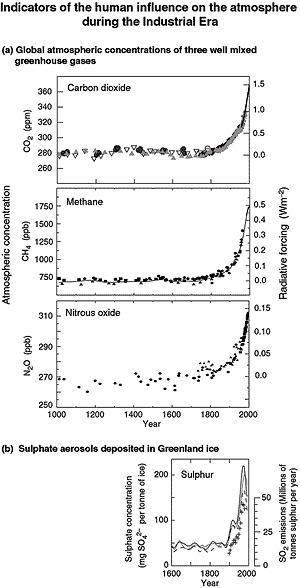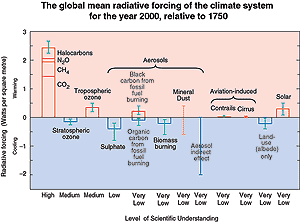 Figure 2: Long records of past changes in atmospheric composition provide the context for the influence of anthropogenic emissions. (a) shows changes in the atmospheric concentrations of carbon dioxide (CO2), methane (CH4), and nitrous oxide (N2O) over the past 1000 years. The ice core and firn data for several sites in Antarctica and Greenland (shown by different symbols) are supplemented with the data from direct atmospheric samples over the past few decades (shown by the line for CO2 and incorporated in the curve representing the global average of CH4). The estimated positive radiative forcing of the climate system from these gases is indicated on the right-hand scale. Since these gases have atmospheric lifetimes of a decade or more, they are well mixed, and their concentrations reflect emissions from sources throughout the globe. All three records show effects of the large and increasing growth in anthropogenic emissions during the Industrial Era. (b) illustrates the influence of industrial emissions on atmospheric sulphate concentrations, which produce negative radiative forcing. Shown is the time history of the concentrations of sulphate, not in the atmosphere but in ice cores in Greenland (shown by lines; from which the episodic effects of volcanic eruptions have been removed). Such data indicate the local deposition of sulphate aerosols at the site, reflecting sulphur dioxide (SO2) emissions at mid-latitudes in the Northern Hemisphere. This record, albeit more regional than that of the globally-mixed greenhouse gases, demonstrates the large growth in anthropogenic SO2 emissions during the Industrial Era. The pluses denote the relevant regional estimated SO2 emissions (right-hand scale). [Based upon (a) Chapter 3, Figure 3.2b (CO2); Chapter 4, Figure 4.1a and b ( CH4) and Chapter 4, Figure 4.2 (N2O) and (b) Chapter 5, Figure 5.4a] |
